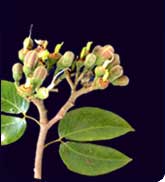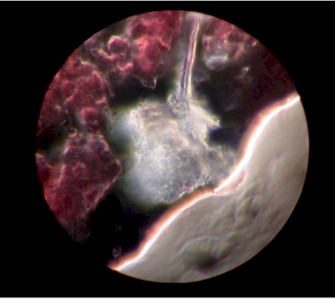Hours before the statute of limitations
was to run out, my lawyer filed a law suit.

The first task was to prove there is mold. We
had the test results from August 2001, but we did not know
exactly how to interpret the results. "Hyphal
fragments" obviously means that the laboratory could
see pieces of hyphae from unidentified spores. This
said, I now understand something that is really important: it
also means that the mold is colonizing and active. I
did not understand this until attending the seminar last
week. Also, it was not until just recently that I understood
that hyphae attach to the lungs . . .
There was a lot more I did not understand,
so let me continue the story.

I ordered another inspection,
this time with the intent of finding all problems. For
those faced with similar dilemmas, let me simply say that
an air quality test can be useful, but if mold is found,
the cause must be identified and corrected. This requires
an inspection, and this is best performed by someone experienced
who understands both construction and mold.
This person will produce a
written report with recommendations upon which his professional
credibility depends. Expect to pay a lot of money for this
kind of test, upwards of $1500 depending on the size of the
property and how many samples are collected.

This time, the type of testing
performed involved a totally different process, something
called lift tape or sometimes tape lifts. Basically,
it is simple enough: gently press the tape against
a suspect surface and send the tape, under chain of custody,
to a licensed laboratory that specializes in mold identification.
Being very interested in microscopy,
I asked if I could be present when the technician examined
the tapes. She phoned me when she found something. Bob,
the man I met at the Seattle seminar, and I rushed over to
see what she had found. She said it was graphium. It
looked very much like what one sees on doctorfungus.org. She
showed me some enlargements that made graphium look like
a nuclear bomb explosion.
It's one of the dangerous molds
and is often confused with aspergillus, meaning the technician
could also have misidentified it. To make a more accurate
ID, one would have to take viable samples and incubate them. This
requires different testing methods.

Bob was the one who interviewed
lawyers specializing in mold litigation; he was the one who
talked to mold inspectors and remediators; and he had also
looked in the microscope at the mold laboratory. In July
2004, Bob died. We had shared many experiences and
become very close so it was a great loss.
One day when I was looking
at my own blood, I felt Bob's presence very strongly. I
could almost hear him telling me to look a little more to
the right of the sample.

In Germany, I had been looking
at a lot of blood samples from patients. We were photographing
much of what we saw and taking special note of objects we
could not identify. It was fascinating, but I never saw
anything similar what I found in my own blood.
This discovery changed my life
and career. If I had not seen this, and if the process
had been more conventional, i.e., based mainly on tests
of cognitive functioning, the direct line connecting air
quality testing and human health would have been lacking.
Unfortunately, I now had proof of mold infection.
Next, I went back over countless
photomicrographs of patients in Germany and Austria. I
realized I had been seeing mold, but not as clearly as on
the pictures above, which are truly excellent images.
There was a patient named Annegret
Ast. She had ovarian cancer. We shared a great
love of animals, and I visited her on her ranch near Salzburg
where she had 42 animals, mostly with histories of neglect
or abuse. I greatly respected and admired her work
and will never forget how an adorable cat named Silver pushed
an apple out the window so a wonderful little Shetland pony
named Lotte could join our breakfast feast one morning. Annegret
had made some apricot liqueur, and we decided to create some
herbal formulas using her homemade brew. I accompanied
her downstairs and was horrified to see black mold on one
entire wall, stretching from the floor to the level of the
hips or higher. It was the wall bearing the brunt of
melting snow. She said that the last person to live
in that house lived to be 92.
She died in October last year
at the age of 52, leaving two children and 42 animals without
a mother.
As I have said, this journey
has been very painful.
With blessings!
Ingrid Naiman
8 October 2005
Ozone 





